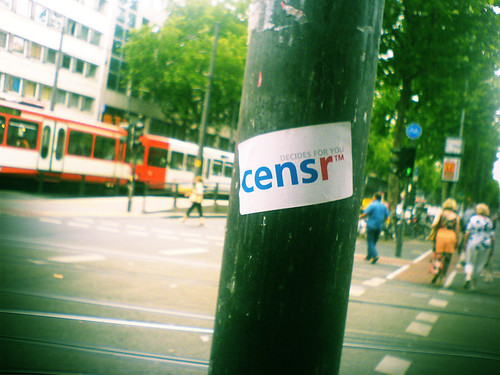flickr's decision to censor content to germany, korea, singapore and taiwan has not gone down well with many of it's users.
i've been using flickr as a networking tool for photography for about 2 years now and i am sad that the management of flickr have deconded to listen to their lawyers rather than their users.
i've been enjoying the freedom of the internet for over a decade now. it seems that freedom is bad for business.
Thursday, 21 June 2007
On the streets of Cologne, Germany
Thursday, 22 March 2007
Water quality
There is a darkroom at my place of work, which is rarely used. I have started using it lately just to load film holders and such. This week I decided to develop some films.
1. The first film was a 120 roll of Delta Pro 400 shot in my Holga. I just used the tap water. When I turned on the tap the water came out orange. Apparently the pipes had not been used for a long time and were full of rust. I let the water run a long time and it cleaned up a bit.
"What the hell", i thought - its a Holga film. I went ahead. Development was unremarkable but the result was filthy and over-developed. The negs were almost black and covered with grains of grit. Washing the grit off caused some scratches. Total write off.
Question - do iron salts in water accelerate the action of the developer?
2. Next batch - 6 sheets of 4x5 delta 100 shot in my Speed Graphic. This time I mixed up the chemicals using water from the water filter in the tea-room. It has two big cartridges full of resins and things. However I rinsed in tap water.
Tray development, timed with music. Result was perfectly developed negs but again with grit from the tap water. Careful washing in filtered water and Photoflo removed this and I am happy with the end product.
3. Last film. having learnt my lesson I developed my final film for the week (a 120 of delta 400 shot in my Rolleiflex) totally in the filtered water, including the rinse - which was the Patterson inversion rinsing technique.
End result was the cleanest set of negs I have ever made. They didn't even need dusting to be printed or scanned.
So - I thought I'd tell my story as an illustration of the need to control water quality - but I'd like to know the answer to my question about iron salts.
Wednesday, 10 January 2007
Photographic time capsule
Here's another found film. It was stored in similar conditions to the other and is a few years younger, but for some reason has faired much worse. This film was exposed in the early 80's and developed just last night.
It shows my eldest son, Kim, with his mother, Jan. There is an odd dendritic intrusion across the image. Fungus? Bacteria? Static electric discharge?
The denity of the image is very low. When I took the negs out of the tank and hung them up I thought there was nothing on the film at all. It was not until I examined them closely that I saw faint mages - barely there at all.
I like lo-fi photography, and I like found films.As a technique though, leaving a film for years before it is developed requires a lot of patience.
Here's an idea. Shoot a roll of film, seal it up and bury it for 25 years. Then dig it up and develop it. I think I may just do that. I know just where to put it too. Watch this space in 25 years for the result....
I may experiment with simply mistreating films. heating them, feezing them, then developing them. I don;t think I'll get those detrite forms again though.
Monday, 1 January 2007
새해복 많이 받으세요!
New Year's wish - a darkroom.
Oh and a house...





